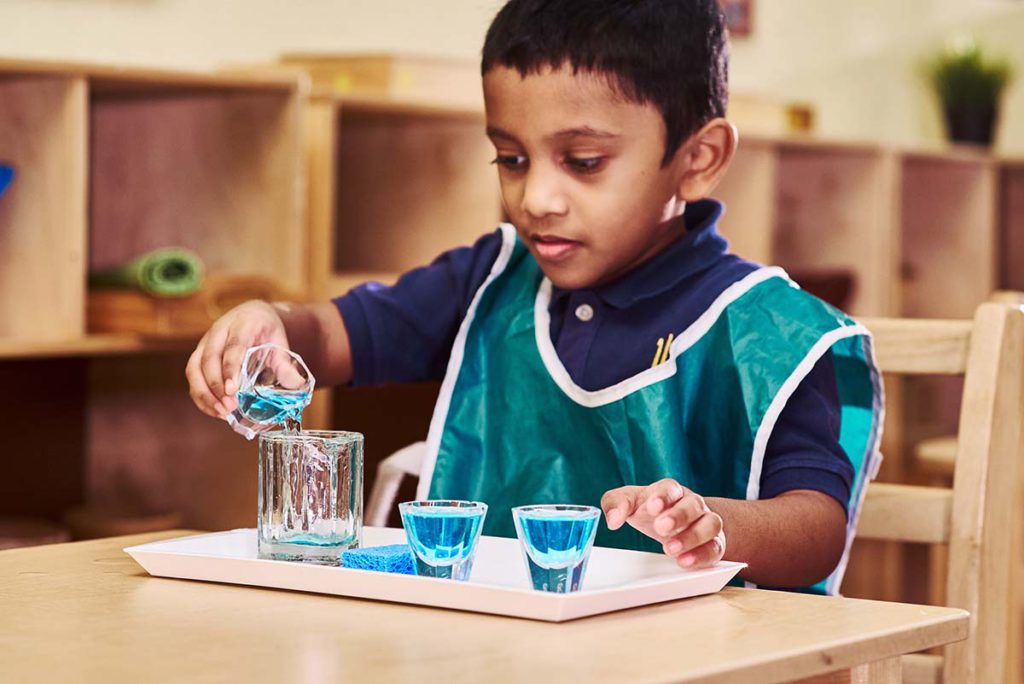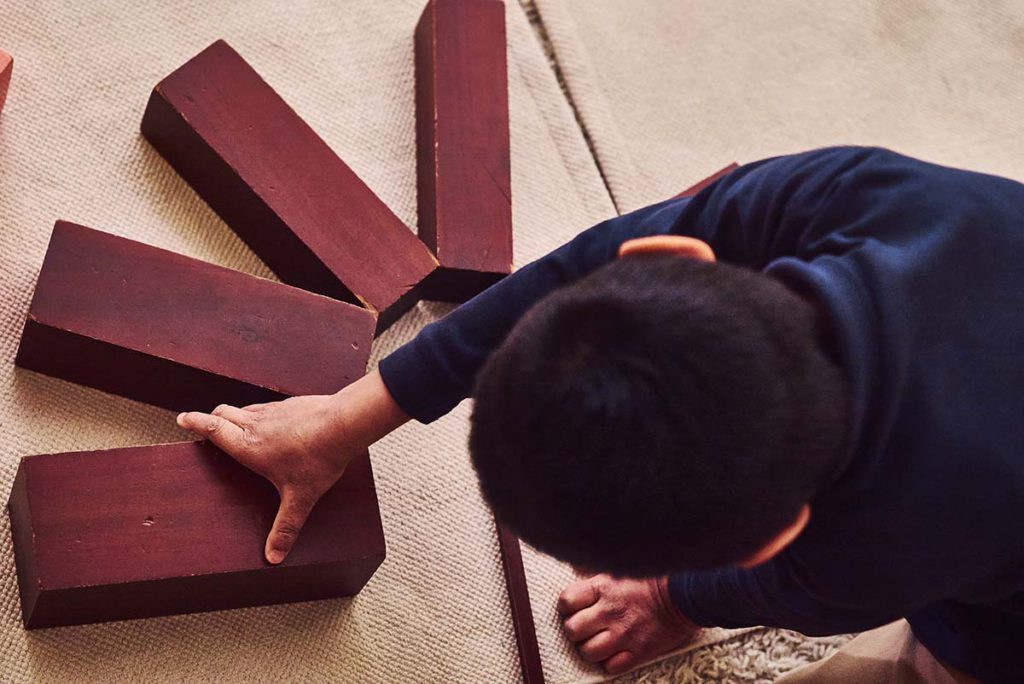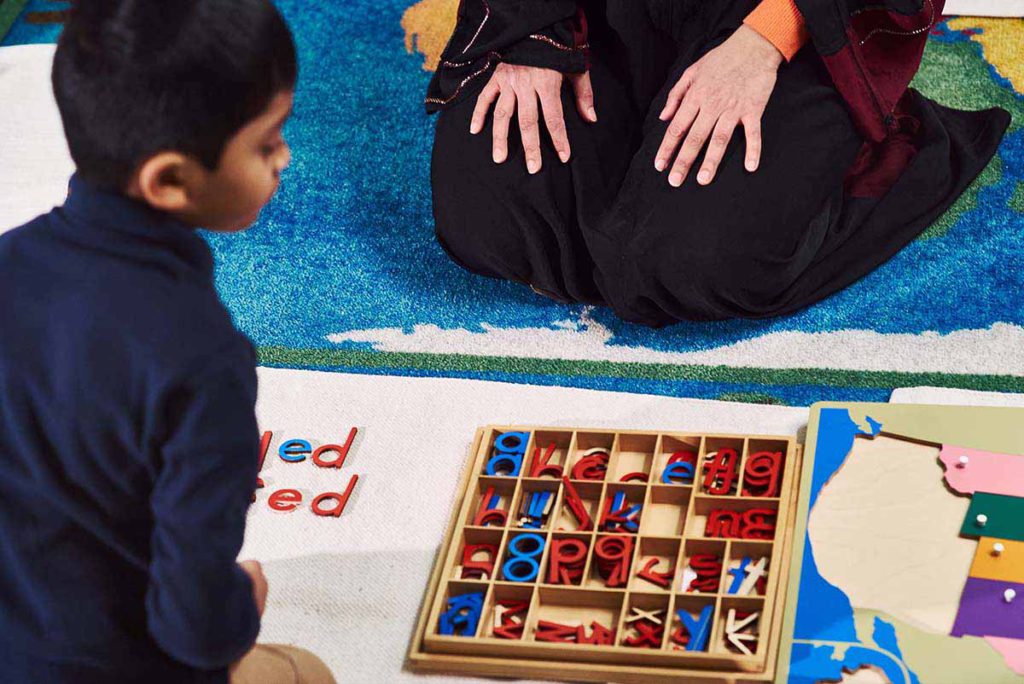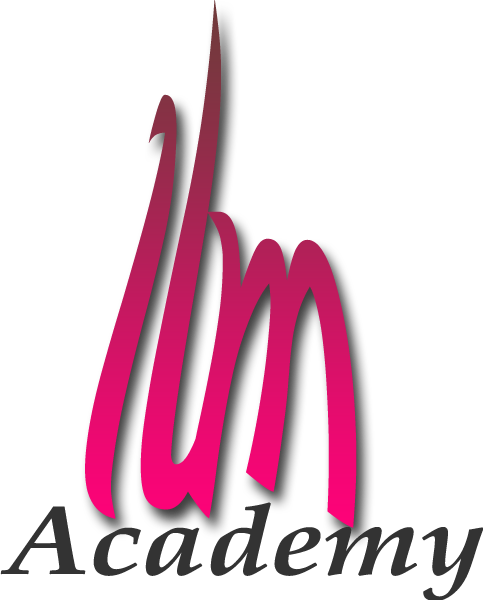EARLY CHILDHOOD PROGRAM curriculum
3-6 Years
ILM Montessori Academy has two primary rooms (Yellow and Green). The learning environment in the classrooms is based on the Montessori Method, which is an approach to learning that engages the whole child. Children are trained to use their five senses, kinetic movement, spatial refinement, and large and fine motor skill coordination. ILM uses this method as a basis for studying mathematics, language, science, art, and the cosmic curriculum which is one of a kind in the Montessori schools. Children’s movement is also developed within the activities in the classroom. The Primary Curriculum consists of the following areas.

Practical Life
The Practical Life area is the foundation of the Montessori classroom. The exercises of Practical Life represent conscious, concentrated activity with intelligent purpose. They are designed to teach the child-specific practical living skills – skills for caring for their own needs, skills for taking care of their physical environment and community, and skills for respectful and responsible communication with others in their lives. Through these activities, the child grows to respect and love the physical world around them, both natural and manmade. Practical Life teaches the child techniques and basic skills for the other areas of development. Practical Life aides in the harmonious development of body and mind. Some practical Life activities examples are:
- Rolling/Unrolling a rug
- Lifting & carrying a chair
- Clamping Clothespins
- Dry/Wet Pouring
- Spooning objects from one bowl to another
- Dry transfer using tongs
- Squeezing wet sponge
- Opening and closing jars/boxes
- Using a strainer, dropper, grater and whisk
- Threading/Lacing
- Using tools such as hammers/screwdrivers
- Buttoning, zipping,
- Walking on the line
- Dusting shelves/materials
- Crumbing
- Sweeping floor
- Watering plants in the classroom
- Use of glue
- Apple cutting/slicing
- Arranging flowers
Grace and Courtesy:
- Making eye contact
- Greeting /handshake
- Apologizing
- Asking for help
- Excusing oneself
- Handling sharp objects
- Interrupting
- Offering a snack
- Watching/Observing a friend
- Walking around a rug
- Speaking softly
- Individual Snack/Group Snack

Sensorial Area
Dr. Montessori recognized that the senses play a fundamental role in the development of the intellect. She believed that the senses are the food of the intellect. The concrete experiences of the sense organs nourish our minds. The sensorial materials serve as a scientific guide for the child to clarify, catalog, classify, and put in order the impressions of her environment. The following below is a sample scope and sequence:
Visual discrimination:
Develops the difference in dimension, width, length, and size can be found in these materials:
- Pink Tower
- Brown Stair
- Red Rods
- Knobbed Cylinders
- Knobless cylinders
- Color tablets box 1,2,3
- Binomial & Trinomial Cube
Tactile Sense
- Touch Boards
- Touch tablets
- Fabric – textures
- Mystery bag
- Sound cylinders
- Smelling Bottles Gustatory Sense
- Tasting Tray
Language Area
One of the qualities that separate the human species from other members of the animal kingdom is our sophisticated use of language. Language skills are perhaps the most important lessons in a child’s life. Dr. Montessori found that when the hand and mind are prepared, writing and reading occur quite naturally. The Montessori classroom offers numerous activities to build the muscular strength and motor coordination needed for writing:
- Concrete objects to teach phonetic sounds
- Sandpaper letters
- Pink series
- Short vowels
- Blue series
- Sight words
- Oral Language Exercises
- Enrichment of Vocabulary

Mathematics Area
The mathematics area is one of the most exciting areas of a Montessori classroom. It is filled with beautiful and fascinating hands-on materials that bring mathematical concepts to life. You will be in awe of the genius of Maria Montessori as you come to understand math as never before. The materials provide a concrete basis for exploration through the senses to enable the child to truly experience the reality of the math concepts before having to apply them in an abstract context. Each new math concept is isolated and presented in a way that gradually moves the child from the concrete to the abstract.
The math activities are organized into five groups. It is not necessary that children will get through all 5 groups. This group introduces sets of one through ten, which prepares the child for counting and teaches the value of quantity. A child will gain a growing understanding of sequence.
0-10 Lesson Plans:
- Sandpaper numbers
- Memory game
- Spindle boxes
- Number rods
- Short Bead Stair
- Other 1-10 additional counting activities the teacher adds reinforce the one through ten numeral concepts.
Decimal Lesson Plans:
These lessons involve the decimal system using the golden bead material. The child will become familiar with the names of the decimal categories, units, tens, hundreds, and thousands. A concrete experience with each category is represented by the beads.
- Decimal Tray
- Golden Bead Layout
Linear Counting Lesson Plans:
Quantity is presented using the teen and ten boards followed by symbol and association. The one-hundred board and bead chains develop number concepts and recognition of numbers one through one-hundred. The bead chains also introduce the child to skip counting; five, ten, fifteen, twenty, etc.
- Ten Board
- Teen Board
- 100 Board
- Short chains
- Long chains
Addition/Subtraction/Multiplication/Division:
These operations are done using the golden bead material. Children work with each other and benefit from these exercises using the bank game. Progression then continues using operations with the stamp game.
- In addition with Red & Blue rods
- Addition Strip Board
- Static & Dynamic Addition with Golden Beads
- Multiplication Board
- Subtraction Strip Board
- Division Board
- Multiplication Board
- Division Board

Cosmic Education
Cosmic education is an incredibly unique and wonderful area in the Montessori classroom. The lesson in this area connects the child with the world around him and gives him a cosmic view of the universe. The activities in these areas are fun, creative, and intriguing. Cosmic Education includes activities in science, geography, art, and movement. These activities bring life and richness to the Montessori environment.
Science (sample):
- Living/Non-living
- Plants & Animals
- Vertebrates & Invertebrates
- Animal classification
- Parts of Tree/leaf/Flower/Bird/Horse/Butterfly/Fish/Frog/Turtle
- Life cycles o Apple o Pumpkin o Turkey o Frog
- Magnetism
Geography(sample):
- Land, Air & Water
- Globe
- World Map
- All continents
- United States of America
- Land/Water Forms
OUR TUITIONS
Early Childhood Program:
Full Time: $550 per month for ten months
Part-Time: $400 per month for ten months
